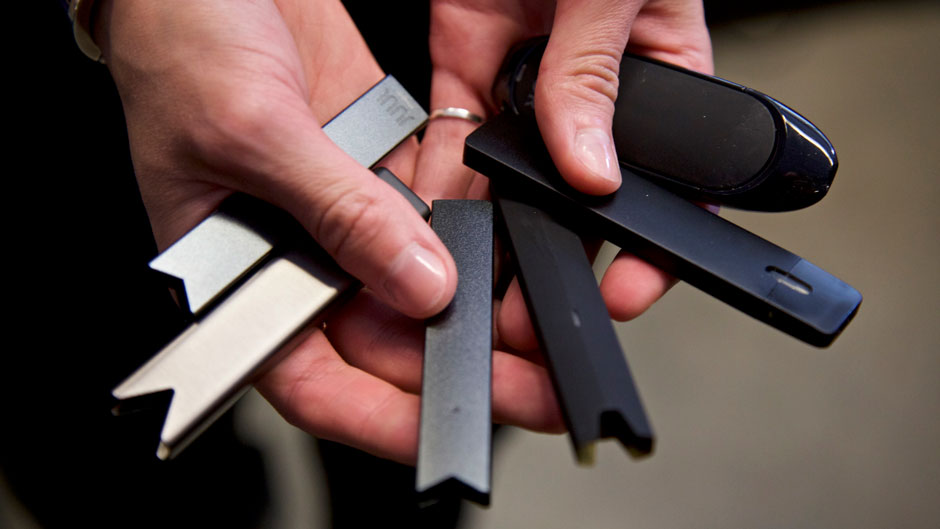Senior Samantha Medina sees vaping everywhere, especially at off-campus parties.
“I’ve tried it before because it looks cool, but I didn’t get the hype,” said Medina, a marine science, physics, and math major at the University of Miami.
Another student said she was shocked to see her roommates, who are nursing students, vaping.
Sophomore Maia Barile said vaping is so common that she decided to become a peer educator at Student Health Service partly to help people kick the habit.
“A lot of people are already addicted at this point,” said Barile, a public health major, adding that her boyfriend and a close friend are among them. “They are scared and want to quit.”
Concerned about the prevalence of vaping, Barile joined administrators and staff to organize the first ‘Canes Against Vaping Week, which begins today. Throughout the week, which is sponsored by the Florida Department of Health, Student Health Service, and the Sandler Center for Alcohol and Other Drug Education, students will receive information about vaping via social media.
On Wednesday, Nov. 13, Barile and other peer educators will be at the Rock Plaza disseminating information about the resources that are available to help people quit vaping. The University has a strict no smoking policy on campus, which includes vaping and carries a $250 fine.
ROOTS OF THE PROBLEM
Vaping, which is the act of inhaling and exhaling the aerosol, or vapor, produced by e-cigarettes or similar devices like JUUL, has exploded over the past two years. Originally, it was assumed that e-cigarettes — which do not produce tobacco smoke — would help smokers kick their unhealthy nicotine habit in a way that was less harmful to their lungs.
Also, due to advertising targeted at youth, many students continue to think that vaping is much healthier than smoking cigarettes, or is safe, Barile said.
“A lot of people were just fooled into thinking that vaping was way better than cigarettes and that they would not have any adverse health effects,” she said.
But the prevalence of vaping has now triggered a public health crisis. At last count, the U.S. Centers for Disease Control and Prevention (CDC) said there have been 1,888 vaping-related lung injuries since January of this year, and 37 deaths nationwide.
“It’s kind of backfired on us,” said epidemiologist Denise Vidot, an assistant professor at the School of Nursing and Health Studies.
Vidot, who studies smoking and cannabis use, said that vaping is so dangerous because the industry is unregulated and many users buy cartridges or pods for their e-cigarettes or other devices not only to vape nicotine, but also what they think is THC, the mind-altering component in marijuana, or other drugs. But they have no way to know what they are really inhaling.
“It’s hard to help people if we don’t know what’s in the cartridges they are vaping when they do not get it from a regulated source,” she said.
Dr. Howard Anapol, director of Student Health Service, echoed Vidot's concerns and added that even among devices bought from regulated stores, vaping is particularly harmful because the nicotine delivery is so intense. For example, in JUUL devices, which resemble USB drives and are now the top-selling e-cigarette in the U.S., one pod contains about the same amount of nicotine as a whole pack of cigarettes. Nicotine use in adolescents can affect learning, memory, and attention, the CDC reports.
“Vaping has all the risks of nicotine, but in a more concentrated fashion,” he said.
The fascination with vaping has largely exploded among young adults in the past two years. According to the National Youth Tobacco Survey, vaping increased by 78 percent among high school students between 2017 and 2018. In Florida, one in four high school students said they had vaped in 2018. And 16 percent of the University’s first-year students who answered a survey as part of a required substance abuse course said they had vaped before setting foot on campus, while only about 4 percent said they had smoked a cigarette.
“Most people who vape have never even smoked cigarettes, which is pretty wild,” said Barile.
One positive outcome from the frightening headlines about vaping is that some students are now concerned about their habit and seeking help. Anapol said some students have visited the health center with anxiety about the possibility of getting lung-related illnesses.
A HOPEFUL SHIFT
After being at the University for a month, first-year students were again surveyed, and just 13 percent of the freshman class said they had vaped since arriving, a decline from the initial survey, said Whitney Platzer O’Regan, assistant dean of students and director of the Sandler Center.
At orientation, new students learn about the University’s strict no smoking policy, which includes a $250 fine implemented last fall, said Ryan Holmes, dean of students and associate vice president for student affairs. Those two factors may have deterred vaping on campus a bit, he said.
Platzer O’Regan hopes that this week’s focus on vaping, will continue to discourage the practice. The Sandler Center has its own team of peer educators who speak to students about the dangers of vaping, along with other alcohol and drug prevention activities. These peer educators will be working to raise awareness this week, so that ’Canes who have not vaped will never start.
“It really comes down to just thinking twice about what substances you are putting into your body and making an educated decision on what effects it may have,” she said.
To learn more about vaping, visit: www.miami.edu/vaping
-Ashley A. Williams contributed to this report.

